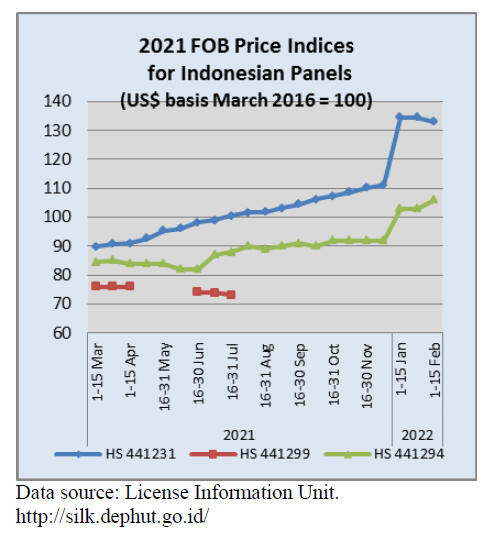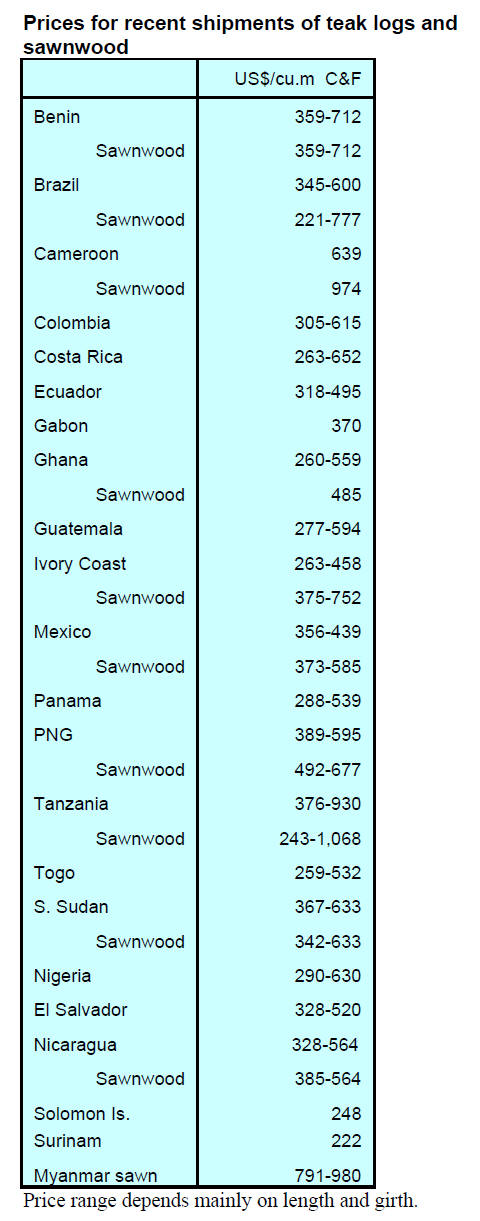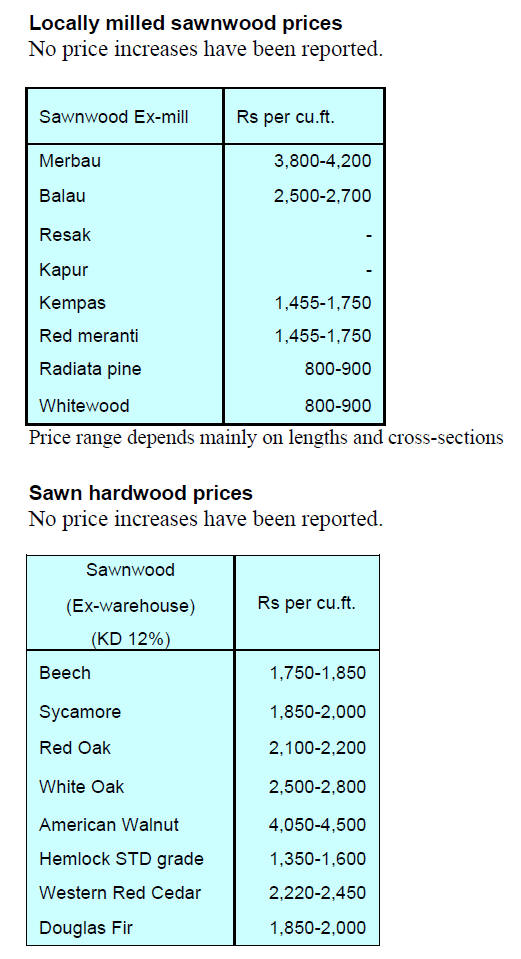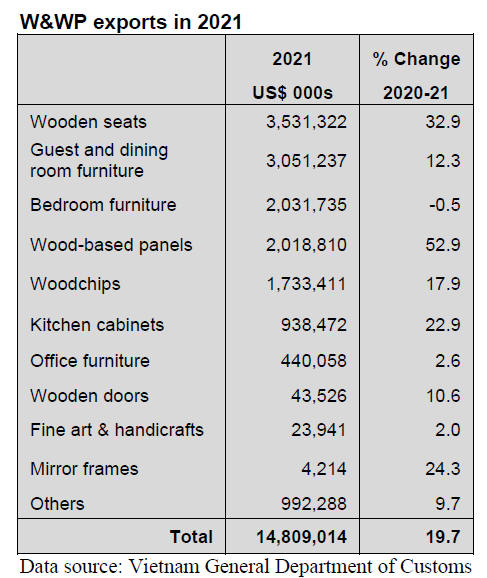
4.
INDONESIA
Furniture factories going under as
shipping costs
soar
Container costs continue to rise and this has become
critical for furniture exporter pushing many SMEs
into bankruptcy. Data compiled by the Indonesian
Furniture and Crafts Industry Association (HIMKI)
shows the cost of container shipments have risen
900% with the current cost for shipping a 40 ft.
container to the US is US$19,100 whereas in 2020 it
was only US$2,000.
The cost for shipping a 20 ft. container is US$15,100,
up 907% from 2020 which was only US$1,500.
Container shipping cost also increased for the EU
market +900%, Middle East +400%, Japan +350%,
Australia +500%. There are difficulties regarding the
availability of containers, especially to America. At
these costs it is not profitable to ship the products.
It has been estimated by the HIMKI that around 25%
of the 2,500 businesses registered as HIMKI
members have gone bankrupt as a result of the high
cost of shipping.
See:
https://www.cnbcindonesia.com/news/20220127131139-4-310925/kiamat-kontainer-serius-pabrik-pabrik-furniturbertumbangan
Indonesia's exports of ‘Light Wood’ products can
grow even more
According to Setyo Wisnu Broto, Chairman of the
Indonesian Lightwood Association (ILWA),
Indonesian exporters have benefitted from the shift
by buyers in N. America from China to Indonesia.
He said two major US buyers are able to absorb as
many as 2,500 containers per month. He said that the
highest demand for ‘Light Wood Products’ is in
America and is said to be worth IDR172 billion of
which Indonesia only supplied a fraction. This must
be increased said Setyo but much will depend on the
availability of raw materials.
See:
https://merahputih.com/post/read/imbas-perangdagang-amerika-dan-tingkok-ekspor-produk-kayu-ringanindonesia-meningkat
Economic recovery appears on track
Febrio Kacaribu, Head of the Fiscal Policy Agency at
the Ministry of Finance, has said the successful
control of the pandemic, public participation in
implementing health protocols and vaccinations, the
effectiveness of fiscal stimulus policies by the
government and good coordination between
ministries has helped accelerate economic recovery.
In 2021 the Indonesian economy grew by 3.69%
which was close to the forecast by the Ministry of
Finance.
In related news the Minister of Finance, Sri Mulyani
Indrawati, expressed optimism that Indonesia’s
economy will grow strongly in the first quarter of
2022 despite the increase in Omicron infections. She
said "If the health protocols are maintained the
impact of the pandemic on the economy will not be
as severe as seen in the first quarter of 2021.
See:
https://en.antaranews.com/news/213069/economicsector-to-show-growth-in-first-quarter-minister
and
https://en.antaranews.com/news/214021/despitechallenges-strong-economic-recovery-appears-on-track
Social forestry is the way forward for Indonesia:
Ministry
Erna Rosdiana, Secretary at the Directorate General
of Social Forestry and Environment Partnership in
the Ministry of Environment and Forestry, has said
social forestry is the future of Indonesia's forestry.
Social forestry has opened opportunities for many
parties after legal access was provided for the people,
she noted.
In Indonesia, social forestry (perhutanan sosial), also
referred as community-based forest management, is
defined as a sustainable forest management system
in the state or non-state forest areas carried out by
the local or indigenous communities to improve their
welfare, environmental outcomes and protect the
socio-cultural heritage.
See:
https://en.antaranews.com/news/211633/social-forestry-isthe-way-forward-for-indonesia-ministry
Regulation to boost rehabilitation of degraded
ecosystems
The government is will soon issue a regulation that
will support a carbon offset mechanism in the
forestry and other land-use sectors, a decision that
will strengthen rehabilitation of degraded ecosystems,
including mangrove forests.
This new regulation will be included in the recently
signed carbon pricing rule that forms the basis of
Indonesia’s carbon pricing scheme.
See:
https://www.thestar.com.my/aseanplus/aseanplusnews/2022/01/31/indonesia-new-government-regulationexpected-to-boost-mangrove-restoration

5.
MYANMAR
6. INDIA
Risk of imported
inflation
The Indian economy continues to face many
structural challenges that existed prior to the
pandemic and new challenges brought on by the
pandemic.
The latest Economic Survey 2021-22 presented by
the Finance Minister, Nirmala Sitharaman, has
forecast the economy will grow by 8-8.5% in the
fiscal year beginning in April.
The Survey notes that supply chain disruptions and
slow economic growth have contributed to an
increase in inflation, also the unwinding of stimulus
measures in developed economies is likely to affect
capital flows into the country.
The survey says “The surge in energy, food, non-food
commodities and input prices, supply constraints,
disruption of global supply chains and rising freight
costs have brought risks of imported inflation.
See:
https://www.firstpost.com/business/economic-surveyof-india-2021-22-gdp-expected-to-expand-at-9-2-keypoints-10335451.html
Covid altered real estate business dynamics
The Confederation of Real Estate Developers'
Associations of India (CREDAI) held a Finance
Conclave in late 2021 to explore new avenues of
financing given the sudden post-covid rise in housing
demand.
Satish Magar, chairman of CREDAI National said
covid has been a great teacher and has altered
business dynamics and led to significant changes in
customer buying patterns. He also mentioned that
more and more milennials are now looking to invest
in a house.
He also mentioned that in response to the many
challenges posed by covid control measures,
especially labor movement, the thought process of
developers has changed and they have begun to
embrace new technology and they have become more
financially disciplined.
The optimistic outlook at the end of 2021 has been
tempered by the pandemic’s third wave which has
dented sales of new homes reversing the upward
trend in sales late last year.
The March quarter is considered as a seasonally
strong period for sales of residential properties but
with consumer concerns over infections and
government restrictions on mobility causing delays in
site visits with potential buyers the sector is bracing
for a slow start to the year.
Sector players had hoped for a boost from the budget
but there was little in it for the housing sector. Even
though real estate sales were almost back to the prepandemic
late last year builders were hoping the
budget would deliver something to boost demand
such as relaxation in GST on under-construction
properties, a reduction of GST on key raw materials,
a higher interest exemption for homebuyers
and granting 'infrastructure' status to the real estate
sector but were disappointed.
However, the Finance Minister did announce
increased spending on infrastructure and made
massive allocations for subsidised housing.
See:
http://timesofindia.indiatimes.com/articleshow/89293011.cms?utm_source=contentofinterest&utm_medium=text&utm_campaign=cppst
and
https://www.credai.org/media/view-details/253
Online Transit Pass facility at Kandla Port
As part of its efforts to improve the ease of doing
business for timber importers and traders the state
Government of Gujarat has implemented a Transit
Pass Management System for Imported Timber, an
online process for facilitating transit passes.
The system provides seamless issuance of transit
passes that helps in monitoring and recording transit
permits for inter-state and intra-state transportation of
timber.
Before the new system was introduced obtaining the
Transit Pass was very time consuming. Kandla Port
has become India’s first port to facilitate online
transit pass. Navneet Gajjar, president of Kandla
Timber Association (KTA) said members greatly
appreciate the efforts of the Gujarat Government
adding that now the process of securing the Transit
Pass has become very efficient.
See:
https://www.plyreporter.com/article/92813/timberimport-online-transit-pass-facility-announced-at-kandlaport
Pay attention to treatment
Media reports say some overseas buyers have
complained of insect infestation in mango wood
handicrafts shipped from the Jodhpur handicraft and
furniture sector. It has been reported that the mango
wood coming from Bengal is to blame.
There has been a strong reaction from exporters who
are suffering financially and the reputation of
Jodhpur handicraft and furniture industry is becoming
tarnished.


Plywood
Manufacturers across India are facing steep increases
in raw material costs which, coupled with the higher
price of fuel, many are seeing rapidly weakening
bottom lines with some having to downsize
operations to stay in business.
Producers have said fuel costs have risen at least
three times in the past six months such that with everincreasing
fuel costs transportation has also become a
cost centre of concern. Soon timber end-users will
have to pay more.

2021 State of Forest report
The Ministry of Environment, Forests and Climate
Change recently released the India State of Forest
Report 2021. The report showed a continuing
increase in forest cover across the country but experts
flagged some of its other aspects as causes for
concern such as a decline in forest cover in the
Northeast and a degradation of natural forests along
with the definition of forest.
See:
https://fsi.nic.in/forest-report-2021-details
7.
VIETNAM
Wood product export prospect for 2022
Vietnam aims to achieve wood and wood products
(W&WP) exports of US$18 billion in 2022. Export
prospects in the US, South Korea and many other
markets look quite bright but not without challenges
for Vietnamese businesses.
W&WP exports in 2021
In 2021 W&WP exports reached US$14.8 billion, up
by 19.7% against 2020. Of this, WP exports
generated US$11.1 billion, up by 16%.

Vietnam’s W&WP export outlook
Do Xuan Lap, chairman of the Vietnam Timber and
Forest Production Association, stated that in 2022
Vietnam’s wood and wood products export would
aim for US$17.5 – 18 billion. In particular, wooden
chair export would aim to account for US$4.1 billion,
wooden furniture US$10 billion.
In the US the trend of working from home may
continue and spending on home and home office
furniture is expected to increase in 2022. The US
market still has plenty of room for growth in wooden
furniture and wood products because the housing
market is growing well.
The share of Vietnamese furniture in total US
imports increased to 38.7% in 10 months of 2021,
from 36.9% in 10 months of 2020. However,
challenges remain when exporting W&WPs to the
US. Trade barriers are the foremost challenge for
Vietnam’s wood exporting companies.
Although Vietnam and the US have reached an
agreement on controlling the origin of wood several
Vietnamese products could be investigated. In
addition, due to a shortage of empty containers,
logistics fees will be a problem for Vietnam’s wood
and wood product exporters.
The cost of transporting one container of wooden
furniture to the US ranges from US$20,000 to
US$30,000, four times higher than pre-pandemic.
According to statistics from the Korea International
Trade Association, on average S. Korea imports
nearly US$1.1 billion of wooden furniture every year
of which imports from Vietnam account for about
18%. Vietnamese wood and wood products still have
room to expand in the Korean market. The Korean
economy shows strong signs of recovery and
domestic consumption is recovering.
Source:
https://vietnamcredit.com.vn/news/vietnams-woodexports-prospect-for-2022_14623
and
https://en.vietnamplus.vn/wood-furniture-exports-to-usexpected-to-hit-10-billion-usd/220865.vnp
Government circular on classifying wood
processing and export enterprises
As a further step toward VPA/FLEGT
implementation, on December 29, 2021, the Ministry
of Agriculture and Rural Development of Vietnam
issued Circular No.21/2021/TT-BNNPTNT to
specify the classification of wood processing and
export enterprises. This Circular will take effect from
May 1, 2022.
The Circular specifies the classification of wood
processing and export enterprises. The targets of this
Circular are enterprises that have simultaneous wood
processing and wood export businesses and
organisations and individuals with activities related
to the processing and export of wooden furniture.
The Circular stipulates the classification of
enterprises based on the principle of ensuring
publicity, transparency, competence, order and
procedures specified in the Government's Decree
No.102/2020/ND-CP dated September 01, 2020, to
promulgate Vietnam’s Timber Legality Assurance
System (VNTLAS).
The forest/wood industry sectors will be focused on
three key product groups including: W&WPs, nontimber
forest products (NTFPs) and forest ecosystem
services to generate revenue and investment in
forestry development. Based on specific advantages,
local conditions and market demands, local
authorities will be encouraged to have policy
mechanisms and prioritise investment resources to
develop key forestry products at the provincial level,
ensuring products of high quality, high value, with
geographical indications and traceability.
In order to achieve the targets VNFOREST has
proposed a number of tasks and solutions such as
continuing to innovate policy mechanisms,
mobilising resources, strengthening communication
and raising awareness; developing and improving the
level of research, application of science and
technology, innovating and improving the quality of
human resource training; synchronous forestry
infrastructure construction, modernisation of forestry
industry and logistics services; improving operational
efficiency, production and business organisation;
strengthening international cooperation, better
utilising market opportunities provided by
international agreements and commitments.
See:
https://tongcuclamnghiep.gov.vn/LamNghiep/Index/cocau-lai-nganh-lam-nghiep-theo-chuoi-va-nang-cao-gia-trigia-tang--4491
Forestry to become modern economic-technical
sector
The Prime Minister has recently approved the
Vietnam Forestry Development Strategy for 2021-30
with a vision toward 2050. Under Decision 523/QDTTg
dated 1 April 2021 the strategy is to convert the
forestry sector into a modern economic-technical
sector and establish, manage, protect, develop and
sustainably optimise forests and forest land areas.
This strategy aims at guaranteeing equal participation
of economic components to forestry activities,
mobilising social engagement and boosting scientific
and technological applications to forestry
development.
The strategy also centres on the role of forests in
socio-economic development, protecting the
environment and water security, mitigating natural
disasters, responding to climate change and
preserving natural resources and biological diversity.
Through this strategy Vietnam can become one of
world’s leading manufacturing and trading centres
for wood products. Application of technology is
expected to contribute up to 30% of sector growth.
See:
https://vietnamlawmagazine.vn/forestry-to-becomemodern-economic-technical-sector-37702.html
Vietnam to pilot carbon trade exchange
On 7 January the government issued a decree
requiring the establishment and trial operation of a
carbon trading exchange by 2025.
According to Decree 06 on mitigation of greenhouse
gas emission and protection of the ozone layer by the
end of 2027 legal norms on management of carbon
credits, commercial exchange activities and carbon
credits will be issued and a regulation on operation of
a carbon credit exchange will be enacted.
A pilot mechanism for exchanging and offsetting
carbon credits in potential sectors will be
implemented, while guidance on implementation of
the domestic and international carbon credit
exchange and offsetting mechanism will be provided
in accordance with Vietnam’s law and treaties to
which the country is a contracting party.
By 2028, the carbon credit exchange will be put into
official operation and activities of connecting and
exchanging domestic carbon credits with regional
and global carbon markets will be regulated. Under
the new Decree, exchange of greenhouse gas
emission quotas and carbon credits must be carried
out on the carbon credit exchange and domestic
carbon market.
See:
https://vietnamlawmagazine.vn/vietnam-to-pilotcarbon-trade-exchange-48233.html
8. BRAZIL
More time at home – furniture sales
get a boost
The pandemic has meant people spend more time at
home which has stimulated investment in home
improvements and one sector that benefited from this
is the furniture sector.
The firm demand seen in 2020 extended into 2021
and it is estimated that furniture sales in Minas Gerais
State have grown about 2% over the previous year.
The increase could have been higher but for the
problems the sector faced in securing production
inputs and the rising prices of raw materials. For
example, prices for one of the main inputs, MDF
panels, more than doubled.
Expectations for 2022 are positive for the furniture
sector. Demand growth will be driven by civil
construction which is on the rise and job growth
which will lead to increased purchases.
The advance of the vaccination efforts and the
resumption of social activities also favoured the
furniture sector.
Overall, the timber sector achieved positive results in
2021 despite the pandemic, global economic
uncertainty, rising production costs and logistics
problems. In 2021 forest production and processing
were little affected. International market demand was
firm in 2021 and Brazilian products could satisfy
some of this demand in North America, European
and Asia.
In the domestic market the timber industry was able
to supply the main consumer markets such as
construction, packaging and furniture. The timber
sector was successful in maintaining jobs despite the
official unemployment rate of 12% in late 2021. The
outlook for 2022 is positive in terms of the
resumption of global economic growth, investments
in infrastructure and resumption of domestic and
international demand.
Mato Grosso manufacturers increased wood
product exports in 2021
The Mato Grosso State, one of the largest tropical
timber producing states in the Amazon region,
achieved an 18% increase in export earnings in 2021
to reach US$21.5 billion. According to FIEMT
(Federation of Industries of Mato Grosso State) it is
likely that exports of wood products in 2022 will
grow even more due to the advance of vaccinations
and the improving the pandemic situation.
According to IEMI (Market Intelligence Institute)
furniture production in the country in 2021 grew
2.7% in volume and 9.8% in revenue compared to
2020 recovering most of what had been lost in the
previous year. Exports jumped 50% in 2021
compared to 2020 and earned US$898.7 million.
Even though Brazil is the sixth largest furniture
producer in the world the country is placed in the
28th position in the ranking of the largest exporter,
well below its potential. The United States remains
the main destination for Brazilian furniture importing
35% of Brazilian furniture exports in 2021.


9. PERU
Furniture imports – Brazil the top
shipper
In November 2021 Peruvian imports of wooden
furniture reached US$6.5 million, more than double
that in October. Brazil remained the biggest supplier
in November 2021 shipping US$4.2 million and
accounting for almost 65% of the total imported in
the month. The second largest supplier was China
($0.9 million) and Colombia ($0.4 million).
Wood product exports began recovery in 2021
The Association of Exporters (ADEX) has reported
that the value of wood product exports in 2021
totalled US$122.8 mil., up 31% compared to 2020
(US$93.9 million) however, the value of 2021
exports was still below that in 2019 (US$124.9
million).
ADEX also pointed out exports by the forestry sector
represented just 0.75% of the total of all nontraditional
exports and that this needs to be corrected
through government measures that promote the
development of the sector since it generates formal
employment much of which is in rural areas.
The Commercial Intelligence unit ‘ADEX Data
Trade’ has reported of total timber shipments semimanufactured
(US$72.2 million) were the most
important with growth of 30% in 2021 and an almost
60% share of all shipments. ADEX said of
manufactured wood products ipe mouldings,
unassembled strips and friezes for parquet flooring
and other profiled products accounted for most of the
balance.
The second ranked export product was sawnwood
(US$33.6 million) demand for which increased by
34%. Sawnwood accounted for 24% of wood product
exports.
In addition, products for construction (US$6.2
million) were exported; furniture and parts (US$4.2
million); plywood (US$3.1 million); other
manufactured products (US$1.4 million);
sheets/veneers (US$1.3 million), firewood and
charcoal (US$0.9 million) and fibre and particleboard
(US$0.8 million).
Despite declining purchases (-27% in 2021) China
was the top buyer of Peruvian wood products taking
US$36.9 million or around 30% of exports. Other
shipments were to France (US$22.3 million), the US
(US$12.9 million), the Dominican Republic (US$9.4
million) and Mexico (US$8.8 million). Also in the
top 10 export destinations were Vietnam (US$5.5
million), Belgium (US$5.3 million), Denmark
(US$4.4 million), Ecuador (US$2.8 million) and New
Zealand (US$2.6 million).
Direct financing programme for forest plantations
In coordination with the Ministry of Agriculture the
Forest Service (SERFOR) managed to access the
AGROPER┌ Fund which was created in 2009 and
supports small sized forestry operations with an area
of up to ten hectares registered in the National
Registry of Plantations.
SERFOR will be the implementing agency for the
Direct Financing Programme for Forest Plantations
approved by the Board of Directors of AGROPERU.
Funds available up to December 2023 amount to
US$12.9 million.
It is estimated that this can support about 3,300 small
forest plantation producers helping the establishment
of 16,500 hectares. The programme will finance up to
70% of the total cost of the forest plantation.



